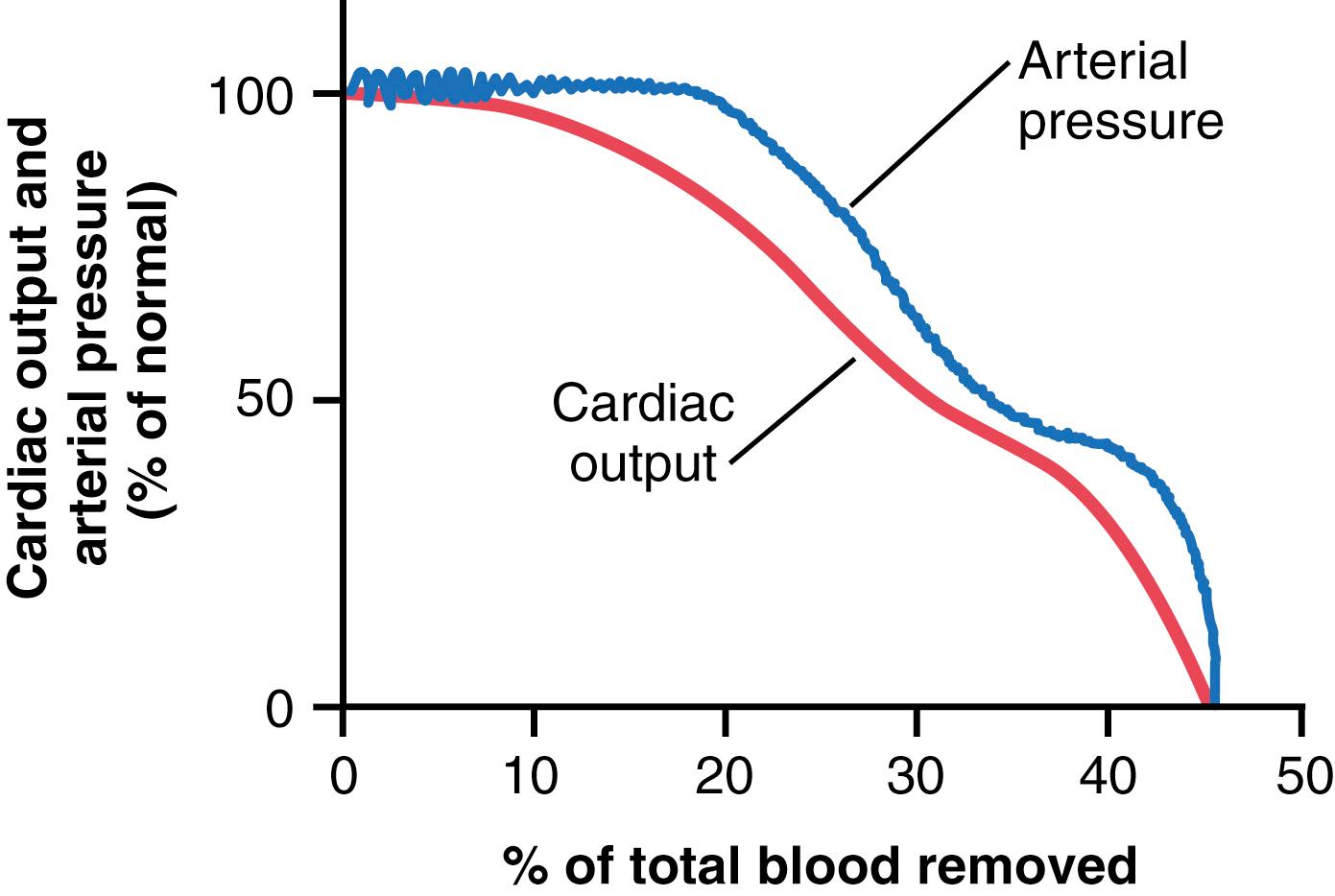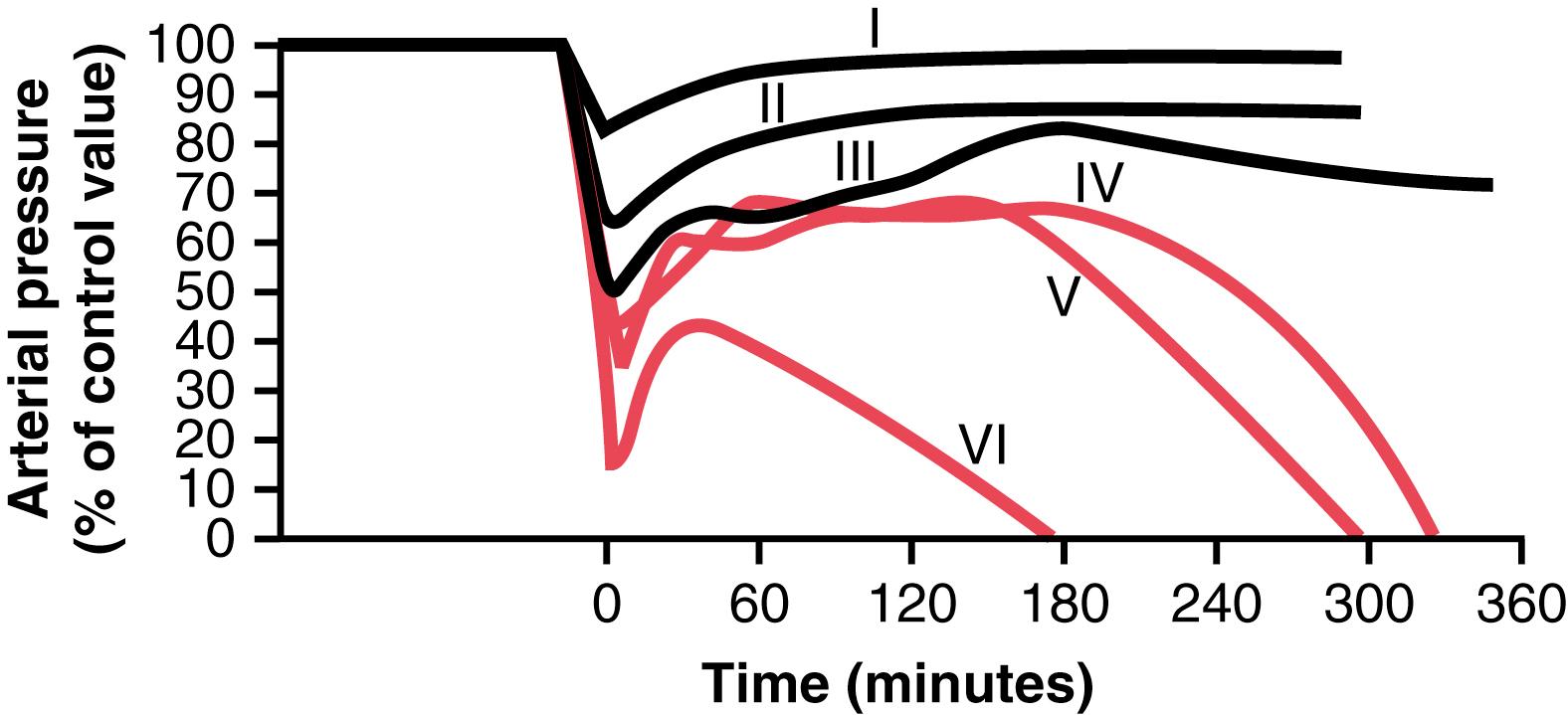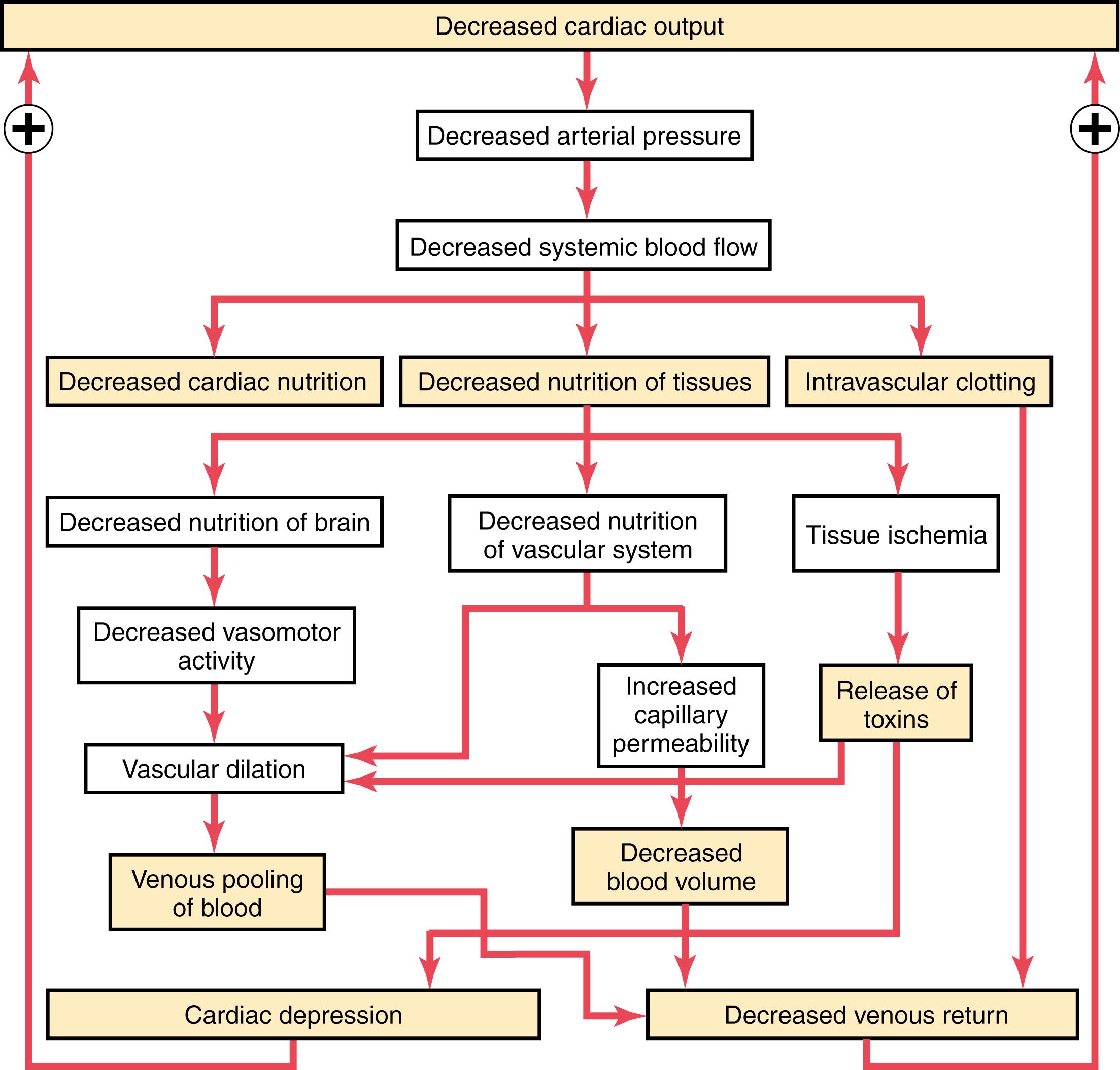Physical Address
304 North Cardinal St.
Dorchester Center, MA 02124
Circulatory shock means generalized inadequate blood flow through the body to the extent that the body tissues are damaged, especially because too little oxygen and other nutrients are delivered to the tissue cells. Even the cardiovascular system itself—the heart musculature, walls of the blood vessels, vasomotor system, and other circulatory parts—begins to deteriorate, so the shock, once begun, is prone to become progressively worse.
Shock usually results from inadequate cardiac output. Therefore, any condition that reduces the cardiac output far below normal may lead to circulatory shock. Two types of factors can severely reduce cardiac output:
Cardiac abnormalities that decrease the ability of the heart to pump blood. These abnormalities include in particular myocardial infarction but also toxic states of the heart, severe heart valve dysfunction, heart arrhythmias, and other conditions. The circulatory shock that results from diminished cardiac pumping ability is called cardiogenic shock. This condition is discussed in Chapter 22 , where it is noted that as many as 70% of people who experience cardiogenic shock do not survive.
Factors that decrease venous return also decrease cardiac output because the heart cannot pump blood that does not flow into it. The most common cause of decreased venous return is diminished blood volume , but venous return can also be reduced as a result of decreased vascular tone , especially of the venous blood reservoirs, or obstruction to blood flow at some point in the circulation, especially in the venous return pathway to the heart.
Occasionally, cardiac output is normal or even more than normal, yet the person is in a state of circulatory shock. This situation can result from the following: (1) excessive metabolic rate, so even a normal cardiac output is inadequate ; or (2) abnormal tissue perfusion patterns, so most of the cardiac output is passing through blood vessels besides those that supply the local tissues with nutrition .
The specific causes of shock are discussed later in this chapter. For the present, it is important to note that all of them lead to inadequate delivery of nutrients to critical tissues and critical organs, as well as inadequate removal of cellular waste products from the tissues.
In the minds of many physicians, the arterial pressure level is the principal measure of adequacy of circulatory function. However, the arterial pressure can often be seriously misleading. At times, a person may be in severe shock and still have an almost normal arterial pressure because of powerful nervous reflexes that keep the pressure from falling. At other times, the arterial pressure can fall to half of normal, but the person still has normal tissue perfusion and is not in shock.
In most types of shock, especially shock caused by severe blood loss, the arterial blood pressure decreases at the same time the cardiac output decreases, although usually not as much.
Once circulatory shock reaches a critical state of severity, regardless of its initiating cause, the shock itself leads to more shock . That is, the inadequate blood flow causes the body tissues to begin deteriorating, including the heart and circulatory system. This deterioration causes even greater decreases in cardiac output, and a vicious cycle ensues, with progressively increasing circulatory shock, less adequate tissue perfusion, and more shock until death occurs. It is with this late stage of circulatory shock that we are especially concerned because appropriate physiological treatment can often reverse the rapid slide to death.
Because the characteristics of circulatory shock change with different degrees of severity, shock is often divided into the following three major stages:
A nonprogressive stage (sometimes called the compensated stage ), in which the normal circulatory compensatory mechanisms eventually cause full recovery without help from outside therapy.
A progressive stage , in which, without therapy, the shock becomes steadily worse until death occurs.
An irreversible stage , in which the shock has progressed to such an extent that all forms of known therapy are inadequate to save the person’s life even though, for the moment, the person is still alive.
We will now discuss the stages of circulatory shock caused by decreased blood volume, which illustrate the basic principles. Then we will consider special characteristics of shock initiated by other causes.
Hypovolemia means diminished blood volume. Hemorrhage is the most common cause of hypovolemic shock. Hemorrhage decreases the filling pressure of the circulation and, as a consequence, decreases venous return. As a result, the cardiac output falls below normal, and shock may ensue.
Figure 24-1 shows the approximate effects on cardiac output and arterial pressure of removing blood from the circulatory system over a period of about 30 minutes. About 10% of the total blood volume can be removed with almost no effect on arterial pressure or cardiac output, but greater blood loss usually diminishes the cardiac output first and later the arterial pressure, both of which fall to zero when about 40% to 45% of the total blood volume has been removed.

The decrease in arterial pressure after hemorrhage, as well as decreases in pressures in the pulmonary arteries and veins in the thorax, cause powerful sympathetic reflexes (initiated mainly by the arterial baroreceptors and other vascular stretch receptors, as explained in Chapter 18 ). These reflexes stimulate the sympathetic vasoconstrictor system in most tissues of the body, resulting in three important effects:
The arterioles constrict in most parts of the systemic circulation, thereby increasing the total peripheral resistance.
The veins and venous reservoirs constrict, thereby helping maintain adequate venous return, despite diminished blood volume.
Heart activity increases markedly, sometimes increasing the heart rate from the normal value of 72 beats/min to as high as 160 to 180 beats/min.
In the absence of the sympathetic reflexes, only 15% to 20% of the blood volume can be removed over a period of 30 minutes before a person dies; in contrast, a person can sustain a 30% to 40% loss of blood volume when the reflexes are intact. Therefore, these reflexes extend the amount of blood loss that can occur without causing death to about twice that which is possible in their absence.
Referring again to Figure 24-1 , note that the arterial pressure is maintained at or near normal levels in the hemorrhaging person longer than is the cardiac output. The reason for this difference is that the sympathetic reflexes are geared more for maintaining arterial pressure than for maintaining cardiac output. They increase the arterial pressure mainly by increasing the total peripheral resistance, which has no beneficial effect on cardiac output. However, the sympathetic constriction of the veins is important to keep venous return and cardiac output from falling too much , in addition to their role in maintaining arterial pressure.
Especially interesting is the second plateau occurring at about 50 mm Hg in the arterial pressure curve of Figure 24-1 . This second plateau results from activation of the central nervous system ischemic response, which causes extreme stimulation of the sympathetic nervous system when the brain begins to experience lack of oxygen or excess buildup of carbon dioxide, as discussed in Chapter 18 . This effect of the central nervous system ischemic response can be called the “last-ditch stand” of the sympathetic reflexes in their attempt to keep the arterial pressure from falling too low.
A special value of the maintenance of normal arterial pressure, even in the presence of decreasing cardiac output, is protection of blood flow through the coronary and cerebral circulations. The sympathetic stimulation does not cause significant constriction of the cerebral or cardiac vessels. In addition, in both vascular beds, local blood flow autoregulation is excellent, which prevents moderate decreases in arterial pressure from significantly decreasing their blood flows. Therefore, blood flow through the heart and brain is maintained essentially at normal levels as long as the mean arterial pressure does not fall below about 70 mm Hg, despite the fact that blood flow in some other areas of the body might be decreased to as little as one-third to one-quarter normal by this time because of vasoconstriction.
Figure 24-2 shows an experiment that demonstrates the effects of different degrees of sudden acute hemorrhage on the subsequent course of arterial pressure. The animals in this experiment were anesthetized and bled rapidly until their arterial pressures fell to different levels. The animals whose pressures fell immediately to no lower than 45 mm Hg (groups I, II, and III) all eventually recovered; the recovery occurred rapidly if the pressure fell only slightly (group I) but occurred slowly if it fell almost to the 45-mm Hg level (group III). When the arterial pressure fell below 45 mm Hg (groups IV, V, and VI), all the animals died, although many of them hovered between life and death for hours before the circulatory system deteriorated to the stage of death.

This experiment demonstrates that the circulatory system can recover as long as the degree of hemorrhage is no greater than a certain critical amount. Crossing this critical threshold by even a few milliliters of blood loss makes the eventual difference between life and death. Thus, hemorrhage beyond a certain critical level causes shock to become progressive . That is, the shock itself causes still more shock , and the condition becomes a vicious cycle that eventually leads to deterioration of the circulation and to death.
If shock is not severe enough to cause its own progression, the person eventually recovers. Therefore, shock of this lesser degree is called nonprogressive shock or compensated shock , meaning that the sympathetic reflexes and other factors compensate enough to prevent further deterioration of the circulation.
The factors that cause a person to recover from moderate degrees of shock are the negative feedback control mechanisms of the circulation that attempt to return cardiac output and arterial pressure back to normal levels. They include the following:
Baroreceptor reflexes , which elicit powerful sympathetic stimulation of the circulation
Central nervous system ischemic response , which elicits even more powerful sympathetic stimulation throughout the body but is not activated significantly until the arterial pressure falls below 50 mm Hg
Reverse stress-relaxation of the circulatory system , which causes the blood vessels to contract around the diminished blood volume so that the blood volume that is available more adequately fills the circulation
Increased secretion of renin by the kidneys and formation of angiotensin II , which constricts the peripheral arterioles and also causes decreased output of water and salt by the kidneys, both of which help prevent progression of shock
Increased secretion by the posterior pituitary gland of vasopressin (antidiuretic hormone) , which constricts the peripheral arterioles and veins and greatly increases water retention by the kidneys
Increased secretion by the adrenal medullae of epinephrine and norepinephrine , which constricts the peripheral arterioles and veins and increases the heart rate
Compensatory mechanisms that return the blood volume back toward normal , including absorption of large quantities of fluid from the intestinal tract, absorption of fluid into the blood capillaries from the interstitial spaces of the body, conservation of water and salt by the kidneys, and increased thirst and increased appetite for salt, which make the person drink water and eat salty foods if they are able to do so
The sympathetic reflexes and increased secretion of catecholamines by the adrenal medullae provide rapid help toward bringing about recovery because they become maximally activated within 30 seconds to a few minutes after hemorrhage.
The angiotensin and vasopressin mechanisms, as well as the reverse stress-relaxation that causes contraction of the blood vessels and venous reservoirs, all require 10 to 60 minutes to respond completely, but they aid greatly in increasing the arterial pressure or increasing the circulatory filling pressure, thereby increasing the return of blood to the heart.
Finally, readjustment of blood volume by absorption of fluid from the interstitial spaces and intestinal tract, as well as oral ingestion and absorption of additional quantities of water and salt, may require from 1 to 48 hours, but recovery eventually takes place, provided the shock does not become severe enough to enter the progressive stage.
Figure 24-3 shows some of the positive feedbacks that further depress cardiac output in shock, thus causing the shock to become progressive. Some of the more important feedbacks are described in the following sections.

Become a Clinical Tree membership for Full access and enjoy Unlimited articles
If you are a member. Log in here